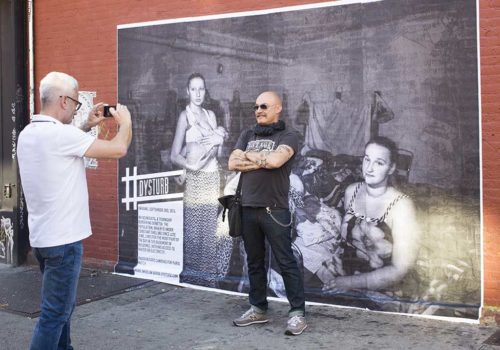151st Street and Courtland, Bronx, New York. 10 P.M. After a session of cutting, it’s time to paste, which can be as quick as Command-V. That’s how long it takes the Dysturb team to put up a four-meter photograph by Pierre Terdjman on 5th avenue. The process is the same—glue, position, unroll, mount—it’s the intention that changes. The adrenaline surges when it’s time to paste the photo on an inviting row of boards between Louis Vuitton and Bergdorf Goodman, and the bold action is halted by a guard who is dedicated enough to throw himself in the glue to protect the provisional property.
Pierre Terdjman and Benjamin Girette’s idea is to put photojournalism in the street, in very large format, to display information somewhere it can have an impact. On 5th avenue, the plan is to interrupt the blind consumerism flooding the streets of this Manhattan neighborhood, which a quick glance at Google Streetview will confirm. In the Bronx, the aim is more social. Passersby react to the photo. The team decided to post a Bryan Denton photo of Syrian refugees in Turkey, and an Andy Rocchelli photo taken in Ukraine. A neighbor explains that he prefers the Rocchelli photo because it’s less sad with all the children, even though they’re in a bomb shelter. A piece of graffiti sticks out from the image, a person in a hat and mustache. The paradoxical juxtaposition, although involuntary, calls to mind the absurd coincidencess of reality: that at the same time on earth, some are soaking up the sun while others are dodging bombs.
Everyone has their idea of an ideal place. The proposals come together. Wall Street! The Hasidic neighborhood in South Williamsburg! A taco truck! Chelsea! The night before, they had put up, on a Manhattan roof, an Andy Spyra portrait of a Boko Haram fighter in Nigeria, and a photography by Ashley Gilbertson in the West Village. It’s photojournalism, in the outdoors, in the street where it can be seen by as many people as in the golden days of the media. And the pictures are in black-and-white, for financial reasons, like a tip of the hat to the same era. To educate, “to teach how to believe in the news,” as Terdjman says, to get a reaction, and stir people to action. Although the project is just beginning—Dysturb began last March—it offers a glimpse of the potential of the model. At a time of hyperconnectivity, passersby by can share their horror and engagement with the click of a button, offering at the same time a possibility of action with a government agency or humanitarian association. Schools are another avenue being explored by Dysturbia.
Today news is consumed as soon as it is recorded, hence the importance of hitting hard and educating. in Williamsburg, a passerby said out loud, upon seeing an Alvaro Canovas photographs from the Ukraine: “That photo’s a month old!” Yes, because the crisis does not pass as quickly as it is forgotten.
We will keep following #Dysturb’s story around the world, and in the Spring 2015 as far as New York is concerned.
















